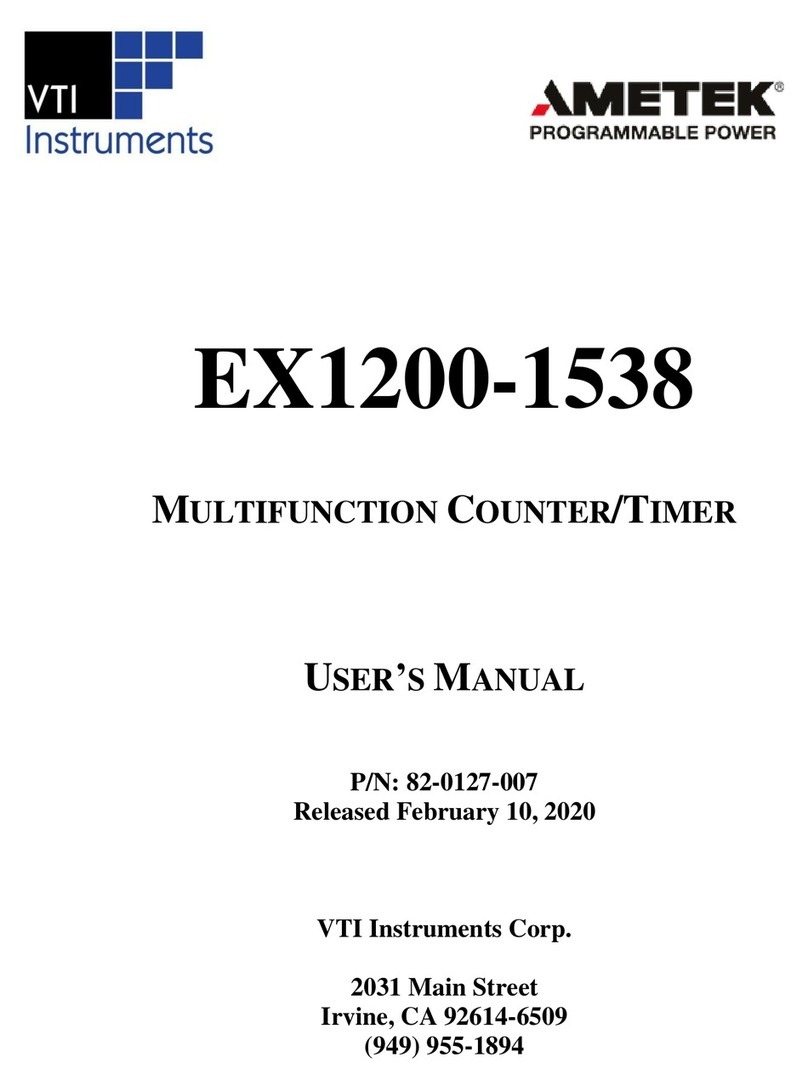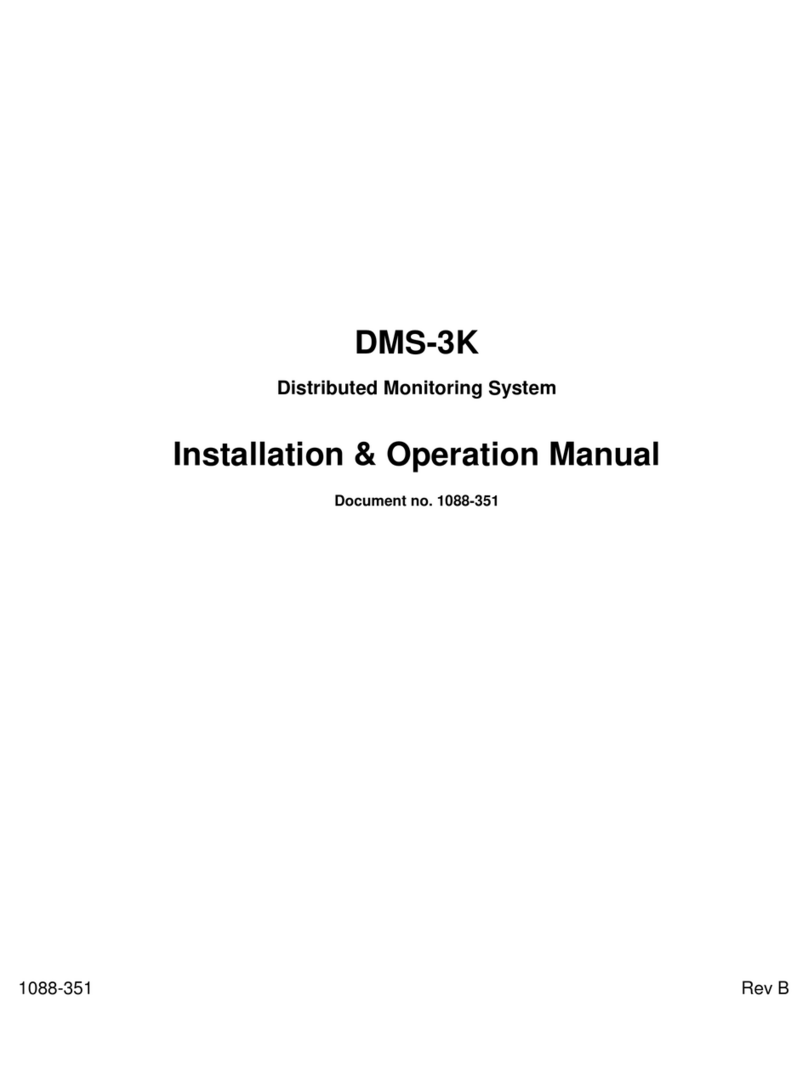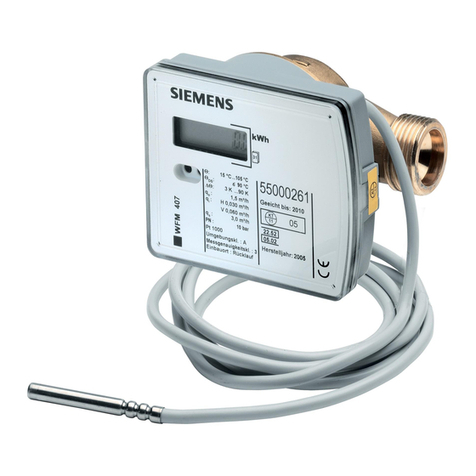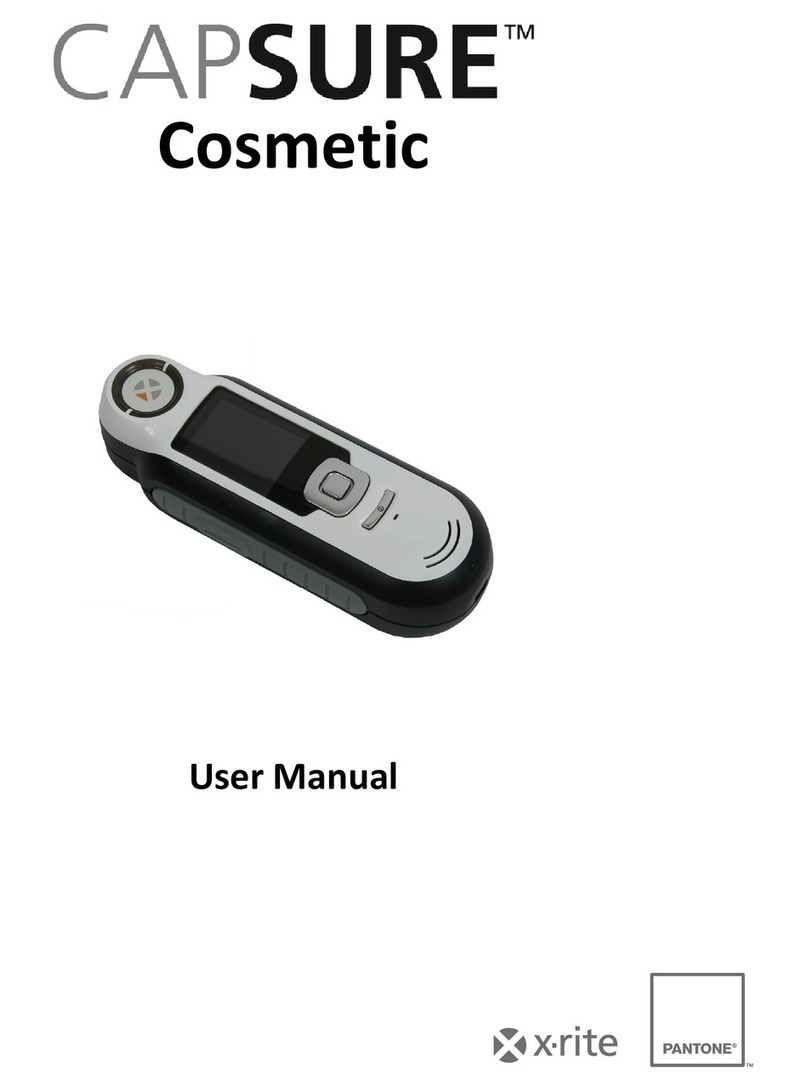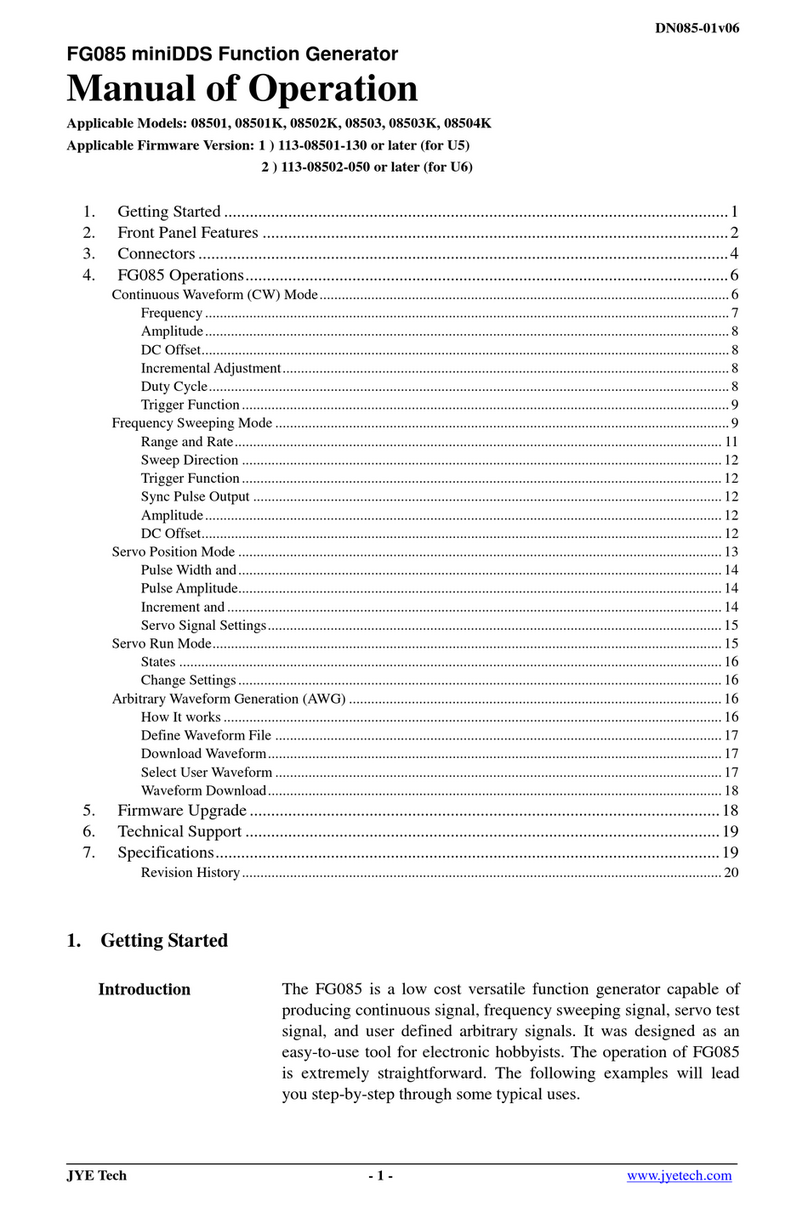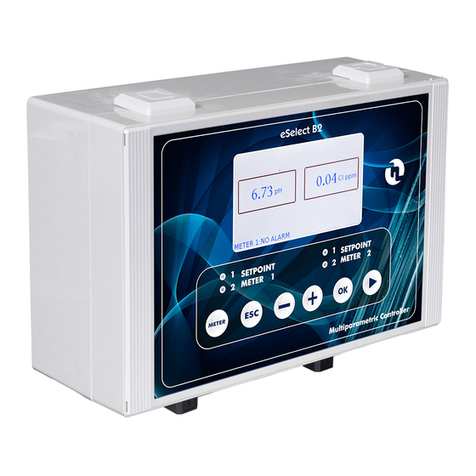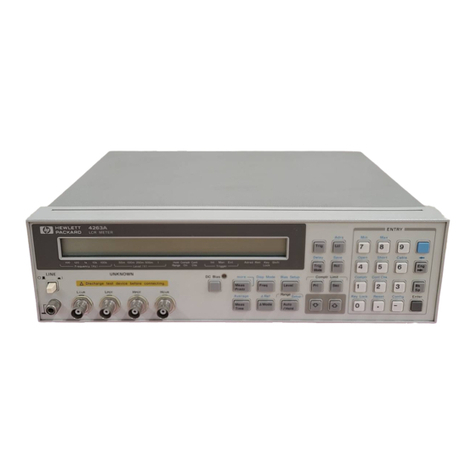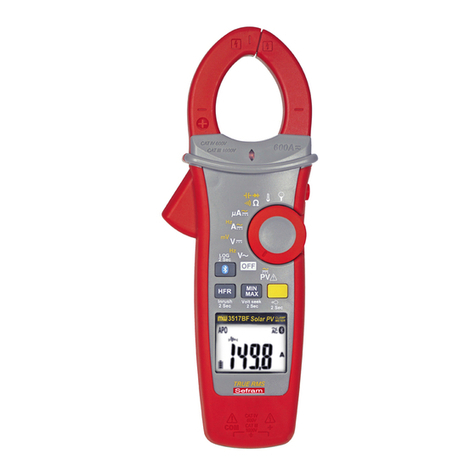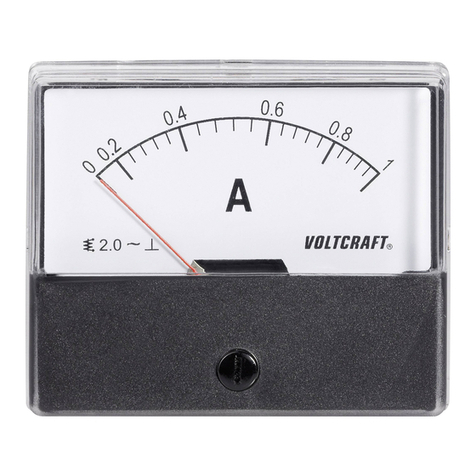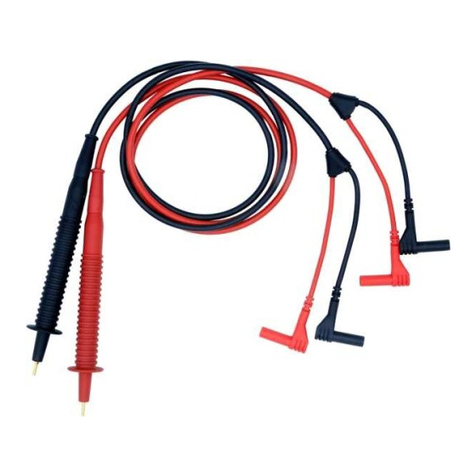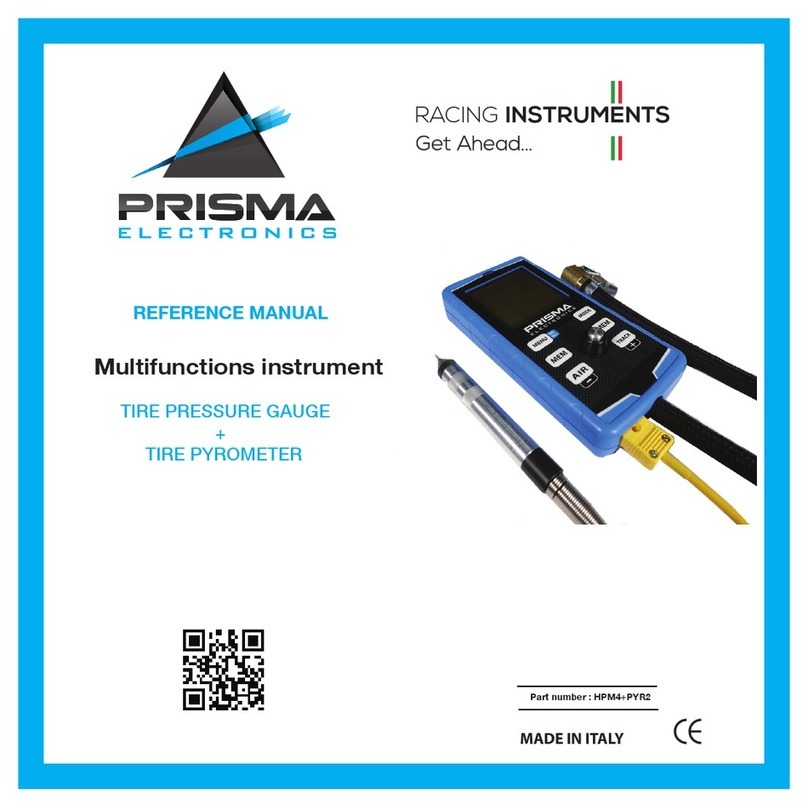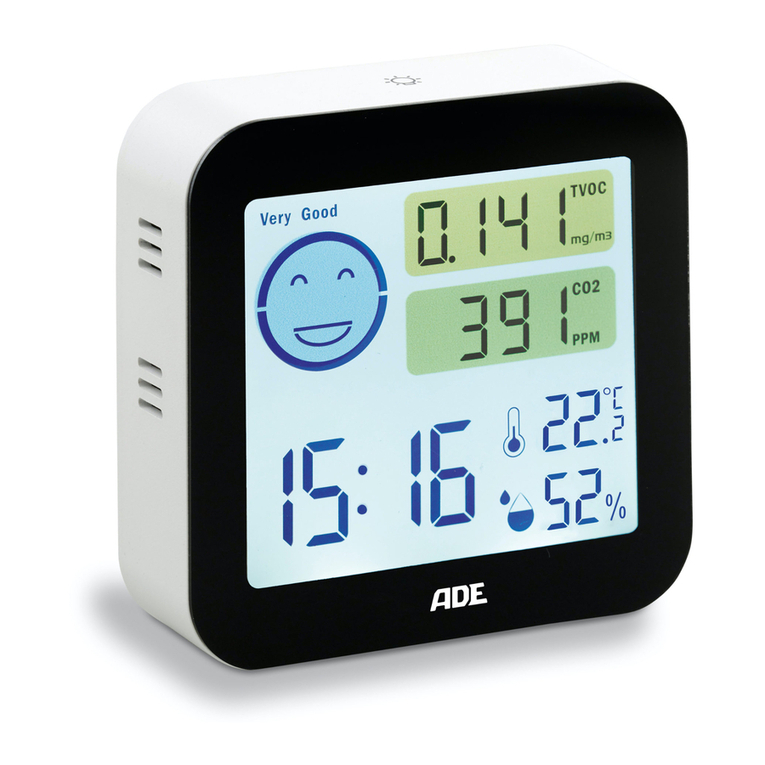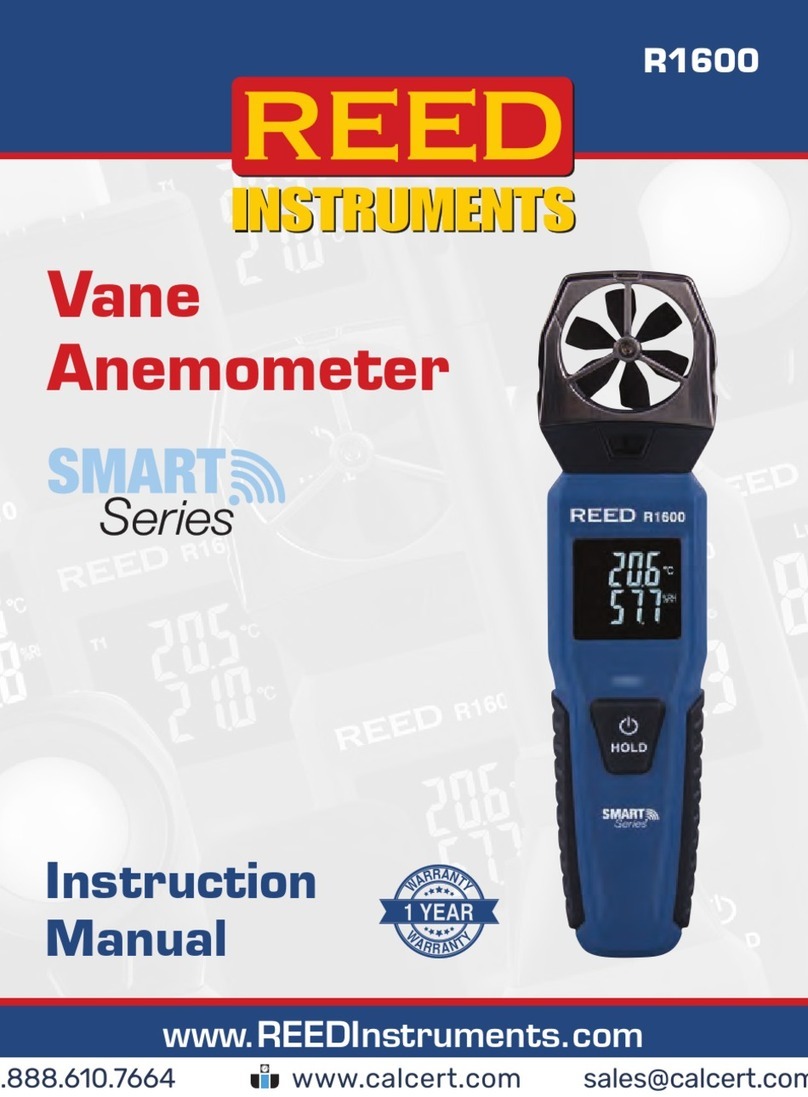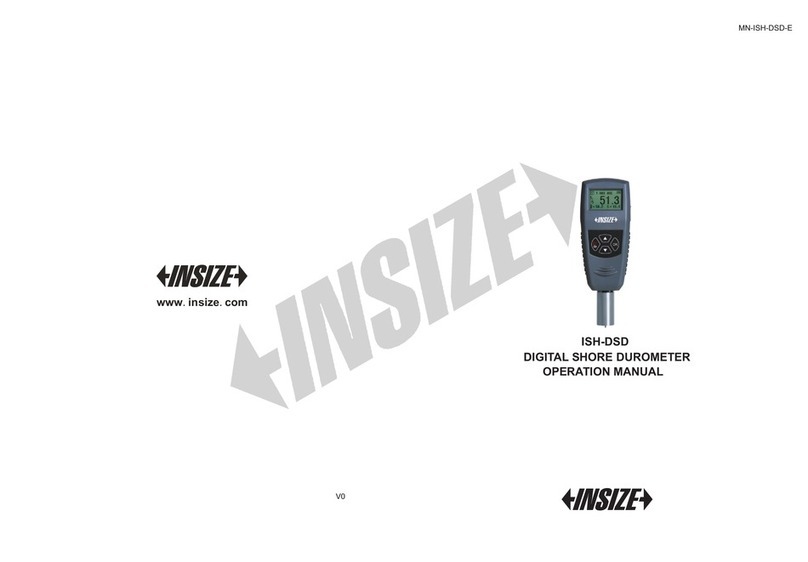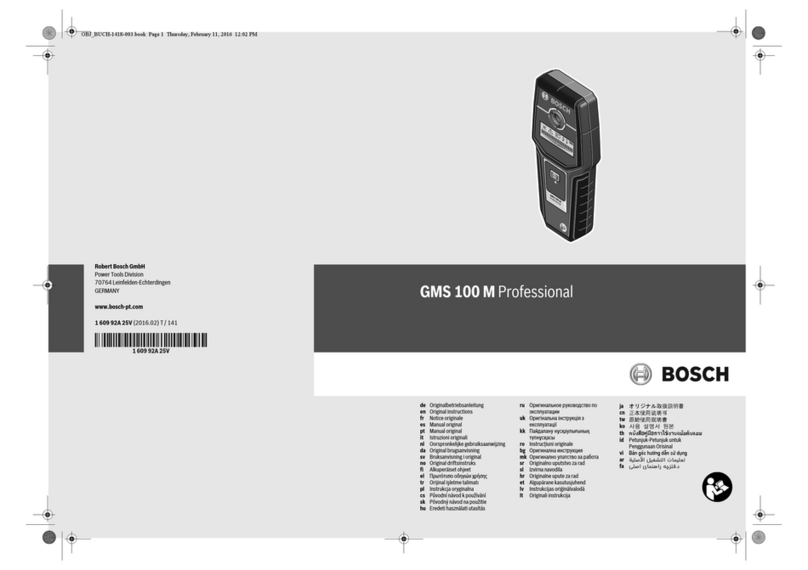Trace2O METALYSER HM4000 User manual

METALYSER®SOILS HM4000
Portable Heavy Metals
Analyser for Soils

2 www.trace2o.com
Metalyser®Soils HM4000
Instruction Manual v3.0
CONTENTS
1. Introduction
3
2. Kit Content
4
3. Metalyser®
5
3.1 Getting to Know Your Metalyser®
5
3.2 Getting Started
15
3.3 Operating Procedure
18
3.4 Troubleshooting
25
3.5 Interference Effects
27
3.6 Specifications
27
4 Soil Extraction Kit
28
4.1 Getting to Know Your Soils Kit
28
4.2 Safety First
29
4.3 Digestion Procedure for Dry Soils
30
4.4 Digestion Procedure for Wet Soils (Quick)
31
4.5 Digestion Procedure for Wet Soils (Precise)
33

www.trace2o.com 3
Metalyser®Soils HM4000
Instruction Manual
v3.0
1. INTRODUCTION
The Metalyser®Soils HM4000 kit is ideal for testing of very low heavy metal
concentrations in soil samples, for example in industrial sites, farms, mines
and river banks etc. The HM4000 is a rugged field kit that tests for a rage of 6
heavy metals and can be used both as a collection and measurement device
for at-site analysis. The kit contains a digestion kit for preparation of soil
extracts. These aqueous extracts can then be analysed using the Metalyser®
instrument. It is very portable, using a battery as its power source and can
provide results to <10mg/kg rapidly.
The Metalyser®HM4000 utilises a voltammetric technique to detect heavy
metal ions in solution. The technique is not new –it was first proposed in the
1920s –but recent advances in electronics and software have provided a
means to make the instrument portable. The instrument takes a complex idea
but makes it easy to understand and is therefore usable for a competent
person not trained in voltammetry. No complex chemical techniques need to
be employed during the course of the analysis.
The HM4000 is very robust and has been designed to be virtually
maintenance free. The instrument is sealed against water ingress and is
housed in a waterproof case, making it suitable for use onsite for carrying out
field screening analysis. The kit is equipped with all necessary
instrumentation, consumables and safety apparatus for safe and precise
analysis of soil samples.
The Metalyser®is ready out-of-the-box and can be used after charging the
built-in battery. After a period of non-use, the Metalyser®is ready to operate
very quickly after putting the sonde head into the water sample.
The soil extraction procedure is outlined in Section 4 of this manual. The soil
extract prepared in this stage can be used for analysis of its heavy metal
contents using the Metalyser®HM4000 instrument as outlined in Section 3 of
this manual.
It is recommended to familiarize yourself with the instrument first using
drinking water samples before advancing to the soil extraction procedures.
Note The results shown will be in units of mg/kg but for water samples this
can be directly correlated to ppb.

4 www.trace2o.com
Metalyser®Soils HM4000
Instruction Manual v3.0
2. KIT CONTENT
Standards
Reference Fill
Solution & Stirrer Oil
USB/AC adapters
Waste Beakers
Sample Analysis
Beaker
Buffer Kit
Instructions
Gloves
Accessories
Cleaning Kit
Filtration kit
Deionised water
Balance
Digestion beaker
Digestants
Clamp
Sample
Collection
Bottles
Mixer
Pipette
Rinse Bottle
Clamp
Plating Solutions
Sonde
Buffer Kit
Instrument
Pipette Tips &
USB Lead
(Beneath
instrument)

6 www.trace2o.com
Metalyser®Soils HM4000
Instruction Manual v3.0
USB Connector
The USB connector can be used to charge the battery using the supplied car
or mains charger, and also for download/upload and charging via a PC or
laptop.
LCD Screen
The LCD screen tells you what is happening as you go along. It will
continually display the current date and time as well as other useful
indicators such as battery and connection status. The screen is also
backlit enabling use of the instrument under poor lighting conditions.
ON/OFF Button
The ON/OFF is used to turn the instrument on and off, there is also an optional
ten minute auto shutdown feature should you leave the instrument unattended.
Navigation Joystick
The joystick allows you to quickly and easily navigate your way through the menus
and features of the Metalyser®. The joystick provides five controls; Up, Down, Left,
Right and OK. To navigate up, down, left and right simply push the joystick in the
required direction. To select an option or ‘OK’ a choice press the joystick in the
centre.
Cancel Button
Pressing the cancel button will return you to the previous menu or screen.

www.trace2o.com 7
Metalyser®Soils HM4000
Instruction Manual
v3.0
On Screen Indicators
At the bottom of the screen thesesymbolswillappearperiodically
to provideinformation about the instrument’s status.
i
i
Battery fast charge indicator
Batterytricklecharge indicator
Batteryfault/overheat indicator
BatteryFull
Battery 3/4 Full
Battery 1/2 Full
Battery 1/4 Full
Batteryempty
Stirrer on indicator

8 www.trace2o.com
Metalyser®Soils HM4000
Instruction Manual v3.0
Components and care of components
The Sonde
The sonde head contains the electrodes, stirrer and temperature probe to carry out analysis.
It comes pre-assembled with the 4 electrodes and a Sample Analysis Beaker (SAB). The
electrodes are the WE1 (Working Electrode 1), WE2 (Working Electrode 2), R (Reference
Electrode) and C (Counter Electrode). The sonde has the electrode letter references
embossed onto it to ensure they are connected in the correct positions.
To fit an electrode, simply align the arrow on the electrode with the arrow on the sonde head
and push the electrode into its socket. A quiet double click should be heard. Gently pull on the
top of the black holder of the electrode to ensure it is fully connected.
To remove the electrodes, pull back the connector shroud with the arrow on and the
connector will pull off.
When attaching or removing the electrodes, be careful to avoid touching the stirrer.
The different Working Electrodes can be identified by the number of connecting pins and are
not interchangeable.
Electrode WE1 (6 pins) is to be fitted in position WE1.
Electrode WE2 (3 pins) is to be fitted in position WE2.
Do not mix up the electrodes as this can cause damage to the instrument.
The sonde can be assembled in one of two ways. Firstly, the short cable attached to the
Sonde can be connected directly to the instrument. It can them be attached to the clamp and
stand included in the kit and fitted inside the box. The second option is to fit the extension
cable between the sonde and the instrument. This allows the instrument to be used to collect
samples as well as analyse them.
The sonde (electrodes x 4) SAB (Sample Analysis Beaker)

www.trace2o.com 9
Metalyser®Soils HM4000
Instruction Manual
v3.0
In-line waterproof cable connector
Warning: Sonde head is designed for submersion up to 1 metre in water. Lowering the head
deeper than this may result in water ingress which will require sonde head replacement.
Note: The sonde cable may be fixed to the lid of the Metalyser®box, using the
box closure tabs and the supplied cable clamp. Alternatively, the user may
attach the cable to a suitable fixture at the sample site, e.g. branch, rope, fence,
barrier.
Alternatively, a clamp and stand are provided. The stand slots into the hole in the right hand
rear corner of the box. This can be used to clamp the sonde as show above, which improves
stability during the analysis.

10 www.trace2o.com
Metalyser®Soils HM4000
Instruction Manual v3.0
Electrodes
Counter electrode –this electrode needs the least maintenance
of all. A quick visual inspection to ensure the electrode has no
physical damage.
Reference Electrode –this electrode contains a liquid filled tube,
the liquid can be replenished by using the Reference Electrode
Fill Solution provided in the kit. Perform a visual inspection to
ensure it has no physical damage and ensure there is enough
liquid in the outer tube and that there are no bubbles in the inner
tube. For best performance, the Reference Electrode tip
should be kept wet. Please remove cap before use, and
replace after use. Always place a few drops of deionised water in
the cap before replacing it on the electrode.
Working Electrode –the electrode surface should be examined
for cracks and imperfections that will affect analysis. The
electrode should be regularly polished to remove contaminants
and ensure a smooth mirror-like surface using the supplied glass
platen, polishing cloth and polishing slurry (see below). Ensure
that the protective rubber cap is replaced during storage of the
electrode to prevent damage to the electrode surface. After
polishing, conditioning steps needs to be undertaken before
analysis. The different working electrodes can be identified by the
number of connecting pins and are not interchangeable.
Electrode WE1 (6 pins) is to be fitted in position WE1.
Electrode WE2 (3 pins) is to be fitted in position WE2.
Do not mix up the electrodes.

www.trace2o.com 11
Metalyser®Soils HM4000
Instruction Manual
v3.0
Refilling the Reference Electrode
The Reference Electrode cap needs to be removed prior to analysis and replaced
when the electrode is going to be stored. It is best practise not to let the tip of the
Reference Electrode dry out. To ensure this, always add a few drops of deionised
water into the cap before replacing on the electrode.
The Reference Electrode must contain Reference Electrode Fill Solution to operate.
Ensure the Reference Electrode is held vertically with the connector upwards and
determine that there is enough solution in the Reference Electrode.
Fill Solution at max Fill Solution level too low
The outer tube needs to be at least 1/3 full. To top the Reference Fill Solution:
1. Place the reference electrode horizontal with the hole facing up.
2. Slide the band down from the hole.
3. Use the pipette to drop enough solution into the reference electrode to fill it up.
4. Once topped up, replace the band to prevent the electrode fill solution escaping.
Note: Only use supplied Reference Electrode Fill Solution.

12 www.trace2o.com
Metalyser®Soils HM4000
Instruction Manual v3.0
Polishing technique for Working Electrode
To carry out analysis, the Working Electrode must first be polished to give a smooth surface
to allow for plating. To polish the electrode, firstly make sure the glass platen and holder are
clean and free of dust or dirt which may cause scratching. Place a clean cloth on the platen
and dampen the cloth with the polishing solution provided. Hold the electrode perpendicular
to the platen and use a smooth figure of eight motion as indicated.
Polish until the surface has a mirror finish and no scratches or imperfections are
seen.

www.trace2o.com 13
Metalyser®Soils HM4000
Instruction Manual
v3.0
The instrument also consists of:
Stirrer –the stirrer will not operate all the time during the different stages of a run.
The stirrer is crucial to the operation of the instrument and needs to be checked to
ensure it is working properly. During a run, look through the translucent beaker or
lightly touch the bottom of the SAB to determine that the stirrer is rotating when
indicated on the handset. The stirrer has been designed to minimise turbulence
thus ensuring increased repeatability. If the stirrer fails to rotate, turn the sonde
head upside down, add a few drops of the Stirrer Oil (do not use any other oil)
down the stirrer shaft at the base near the sonde head (near where it enters the
sonde) and rotate gently to ensure the lubricant coats the bottom of the shaft.
Sample Analysis Beaker (SAB) –the SAB has a fixed volume so that when full
and removed from the water course, excess sample will empty out of the holes
levelling off at a constant volume.
Instrument –the handset is waterproof and robust. A periodic visual inspection to
ensure it is not damaged and that the screen is readable will suffice.
Buffers –the buffers are powders, which should be stored in a dark, cool, dry
environment. If stored correctly, these have a shelf life of 3 years. Refer to
individual sachets for expiry dates.
Standards –the standards should be stored in a dark, cool place and have a
shelf life of 12 months. Refer to standards for expiry dates. Should any
contaminant come into contact with the standards, they should be discarded and
replaced.
Plating Solutions –the plating solutions should be stored in a cool, dark place
and have a shelf life of one year. Refer to solutions for expiry dates. Should the
efficacy of the plating solution deteriorate before this during use, they should be
discarded and replaced.

14 www.trace2o.com
Metalyser®Soils HM4000
Instruction Manual v3.0
Menu System
The Metalyser
®
is controlled
via
a systemof
on-screen
menus.
The
structure of these
menus
is
illustrated
belowto
assist
you in
navigating
them.
Main Menu
Test
Methods
→
Condition/Mix
Used to condition the working electrode ready
for use or mix samples when using digester.
→
Analyse
Sample
Used with Calibrate function. Calibration must
be undertaken before analyse sample can be
used
→
Standard
Addition
Used to analyse samples and calculate the
unknown concentration by the addition of a
known standard
→
Calibrate
Used with analyse sample. Calibration must be
performed before analyse sample is used
→
Blank
subtraction
Used to set or replace a baseline if
contaminants are suspected in the buffer.
Data Log
→
View Log
Data Log viewing options
→
Last Result
Displays latest result and graph
System
→
Backlight
Backlight control options
→
Set date/time
Used to set the instrument date and time
→
Language
Used to select the display language
→
Charge
Battery charging options
→
Auto switch off
Auto off select
→
Program
P/STAT
Program internal hardware (Not used in normal
operation)

www.trace2o.com 15
Metalyser®Soils HM4000
Instruction Manual
v3.0
3.2. GETTING STARTED
Charging the battery
When you first receive your Metalyser®it would be advisable to fully charge the battery.
This can be done several ways using the USB lead and chargers provided with the kit.
Connect the device as shown below, then connect to the chosen charging system
(mains/12V). If a computer is used, the software drivers will need to be installed to
perform a fast charge.
Unscrew the blue cap Insert mini USB lead Tighten the screw cap
The Metalyser®is capable of charging at a fast rate taking approximately 7 hours to
fully charge the battery, or a trickle charge rate which should be used for overnight top
up charge if the instrument is only used once or twice a day.
From the system menu select Charge and you will be given three options:
100mA Trickle charge rate
500mA Fast charge rate
AUTO The instrument will automatically select the best charge rate.
To select the charge rate follow these steps:
• From the main menu select System
• From the system menu select Charge
• Highlight required charge rate and press <OK>
• Press <cancel> to return to main menu
Note: The fast charge option is only available when the instrument is switched on. The
instrument will also charge at a trickle rate if the instrument is connected for charging
but not switched on

16 www.trace2o.com
Metalyser®Soils HM4000
Instruction Manual v3.0
Driver Installation
Your Metalyser®is compatible with most computers with a USB socket, but first the
USB drivers may need to be installed. The drivers are located on the Software USB
stick provided for all versions of Windows post Windows 95.
•Insert the USB memory stick into an available USB port on your PC
•Connect the USB cable supplied to the Metalyser®instrument as described for
battery charging. Connect the other end to an available USB port on your PC
•Windows will run the ‘install new hardware wizard’
•When asked if Windows can connect to Windows update to search for software.
Select ‘No, not this time’
•Select ‘Install from a list or specific location’, navigate to USB memory drive
•Windows should install the drivers
•Once complete the wizard will run again. Use the same settings as before
•Once Windows has installed the drivers, reboot the computer and your
Metalyser®should be installed
•To verify correct installation select fast charge on the instrument and check
that the fast charge icon (see page 7) is displayed on the Metalyser®’s screen
Setting the Date and Time
The Metalyser®contains a calendar and clock which is used todate stamp the results
log. The clock may be set to UTC when you receive the instrument so may need re-
setting. It will also need re-setting if the battery is disconnected. To set the clock
follow these steps.
•From the main menu select System
•From the system menu select Set date/time and press<OK>
•Use the navigation key to alter the date and time
•Press
<OK> when finished to save settings

www.trace2o.com 17
Metalyser®Soils HM4000
Instruction Manual
v3.0
Backlight
Your Metalyser®is equipped with a backlight to aid viewing in poor lighting
conditions. Selecting backlight from the system menu will present the following
options:
ON The backlight will be on at all times1
OFF The backlight will be off at all times
AUTO The backlight will switch on when a key is pressed or the screen
refreshes. It will turn off after five seconds of inactivity.
1 The battery life will be shortened in this mode.
To change the backlight settings follow the steps below.
•From the main menu select System
•From the system menu select Backlight
•Highlight required setting and press
<OK>
•Press <cancel> to return to main menu
Language Selection
The Metalyser®comes with English, French and Spanish languages pre-installed.
To Change the language follow the steps below:
•From the main menu select System
•From the system menu select Language
•Highlight required language;
English,
French, Spanish and press <OK>
•Press <cancel> to return to main menu
Auto switch off
The Metalyser®can be set to automatically switch off after ten minutes of inactivity.
This is recommended to extend battery life. To change this setting select ‘Auto
Switch Off’ from the System menu and then select On or Off.
•From the main menu select System
•From the system menu select Auto switch off
•Highlight required setting and press
<OK>
•Press
<cancel> to return to main menu

18 www.trace2o.com
Metalyser®Soils HM4000
Instruction Manual v3.0
3.3. OPERATING PROCEDURE
3.3.1. METHODS
The Metalyser®operating procedure consists of two main steps –plating
(conditioning) and analysis. The plating step forms a plate on the surface of the
working electrode which can be seen as either a grey or yellow/gold layer on the
tip of the Working Electrode. The quality of this plate is essential to achieving
reliable results.
The following table illustrates which electrode to use for each element.
If WE1 is to be used in the analysis, then WE2 is not part of the circuit and has no role
in the analysis. Likewise for WE1 during analyses using WE2.
When switching between different analyses, the unused electrode needs to be
removed, otherwise results may be affected.
Procedures for each parameter are detailed in the relevant application notes
Elements
analysed
Working Electrode
used
Colour of Working Electrode
after Plating
Cd, Pb
WE1
Grey
Hg
WE2
Yellow/Gold
As
WE2
Yellow/Gold
Cu
WE1
Grey
Zn
WE1
Grey

www.trace2o.com 19
Metalyser®Soils HM4000
Instruction Manual
v3.0
3.3.2. PLATING
This is a process used to form a very thin plate on the surface of the Working Electrode
and only takes a few minutes to complete. The plating step is necessary prior to the
analysis of each element, however it is possible to analyse elements consecutively if they
share a common plating solution (e.g. Cd, Pb and Zn all use HG500 Hg Plating Solution).
Before carrying out the plating step, the Working Electrode surface must be polished to
remove any scratches and imperfections (see page 12).
There are two preliminary steps required for any analysis with the Metalyser®. The
plating step uses the HG500 Hg Plating Solution, HG1000 Thick Hg Plating Solution or
AU500 Au Plating Solution, added to the SAB, to form a plate on the Working
Electrode. After plating, the mirror-finish black tip is covered with a plate that is either
grey (Hg Plating Solutions) or yellow/gold (Au Plating Solutions).
The element being tested determines the plating solution required:
HG500 Hg Plating Solution –Cd, Pb, Cu, Zn
AU500 Au Plating Solution –Hg and As
WE1 is used for Cd, Pb, Cu and Zn analysis
We2 is used for Hg and As analysis
It is necessary to perform the plating and conditioning before an analysis session or if
the sensitivity of the analysis decrease. This is because, over time, the plate will reduce
in thickness and eventually come off. Typically this will be after 20+ consecutive
samples or a period of 2-3 hours. It is therefore suggested to regularly re-plate the
electrode; if analysing a lot of samples, it is recommended to plate in the morning and
again at the beginning of the afternoon session.
If in doubt, remove the old plate by wiping the surface, polishing the tip of the Working
electrode to a mirror-finish (with the polishing kit provided), then rinse with the wash
bottle and perform a new plating.
When analysing for elements requiring a plate different to the one currently being used,
the electrode not in use will need to be removed from the sonde to prevent
interference. It is advised to group together analyses using the same plate to save
switching between them.
The conditioning of the electrode occurs when the element of interest is selected in the
Test Methods menu and then choosing condition electrode, which is at the top of the
list for the selected electrode. The conditioning step should be carried out in sample
water, and undertakes a run which sensitises the Working Electrode.

20 www.trace2o.com
Metalyser®Soils HM4000
Instruction Manual v3.0
Example: Overview of As (III) procedure to first plate then sensitise the electrode:
Main Menu
Choose “Test Methods”
These plating steps
deposit the plate on
the tip of the
Working Electrode
Test Methods Menu
Choose “M2&3 Conditioning”
Half-fill SAB with AU500 Au Plating Solution
After plating, check tip for yellow / gold plate
Return AU500 Au Plating Solution to bottle
These
conditioning steps
(within the metal
menus) prepare
the Working
Electrode for
analysis.
Select analysis method...
Place buffer in SAB and fill SAB with
sample
From the Test Methods Menu, choose
As(III), and then Condition Electrode
Refer to Application notes for Operating Procedures particular to each parameter.
Table of contents
Other Trace2O Measuring Instrument manuals
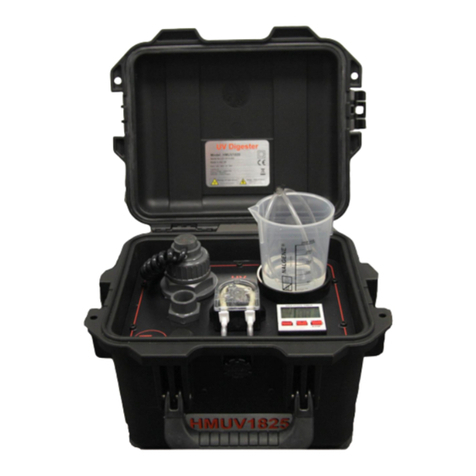
Trace2O
Trace2O HMUV1825P User manual
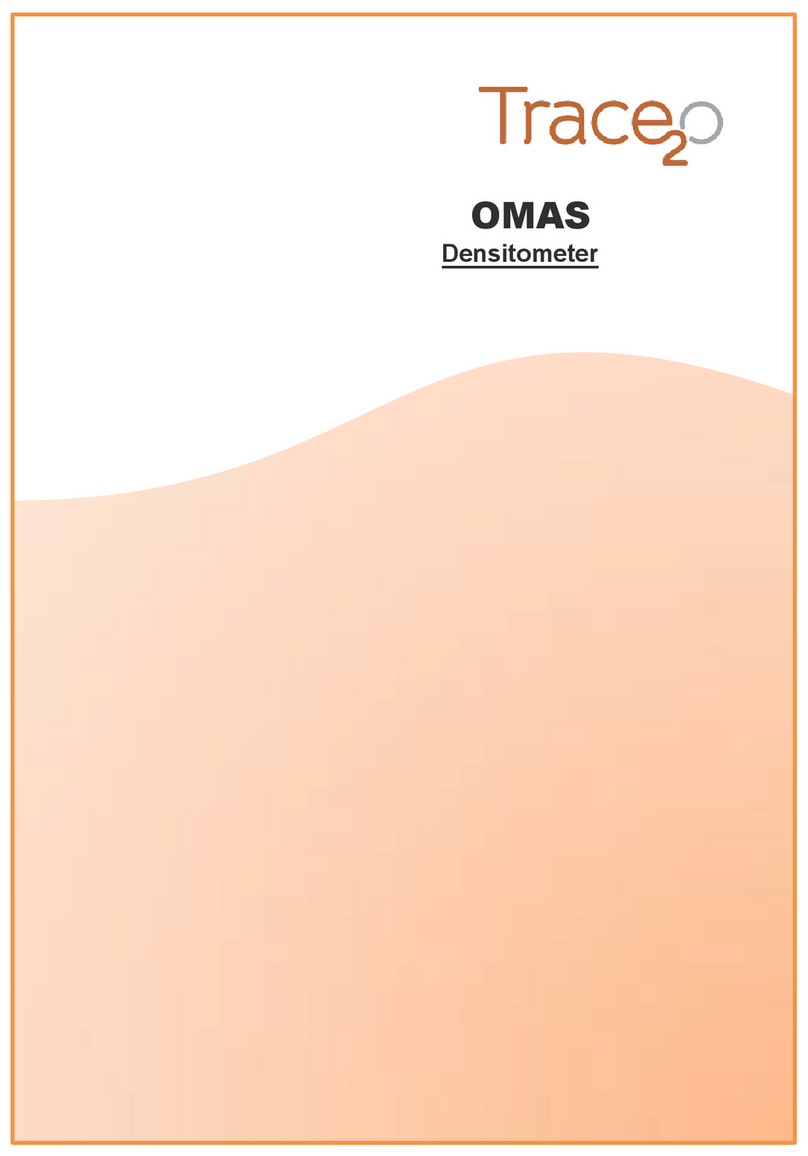
Trace2O
Trace2O OMAS User manual

Trace2O
Trace2O Metalyser HM5000 User manual
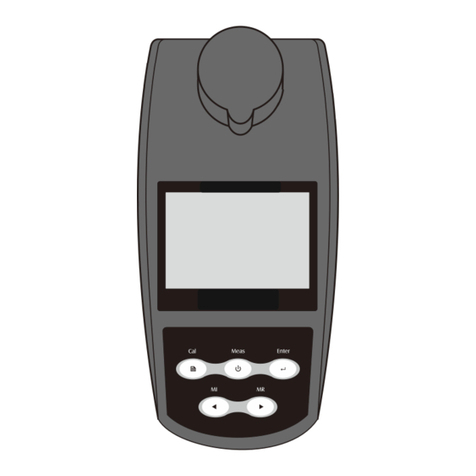
Trace2O
Trace2O HydroTest HTTURB User manual
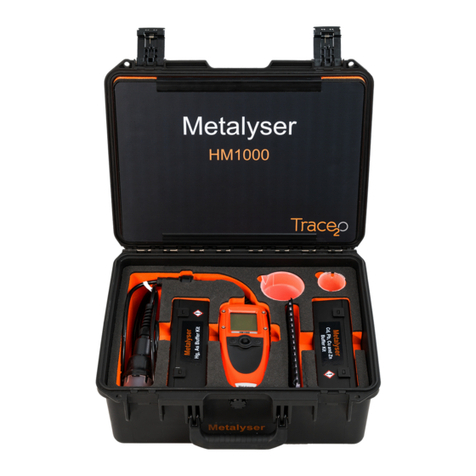
Trace2O
Trace2O METALYSER HM1000 User manual

Trace2O
Trace2O HT1000 User manual

Trace2O
Trace2O METALYSER DELUXE HM2000 User manual

Trace2O
Trace2O METALYSER DELUXE HM2000 User manual
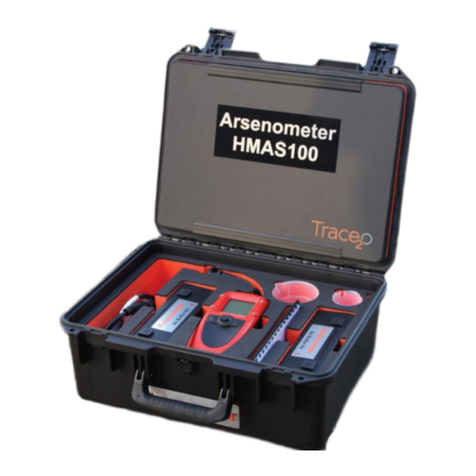
Trace2O
Trace2O ARSENOMETER HMAS100 User manual
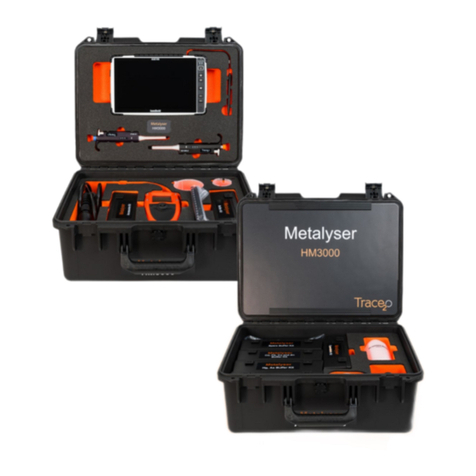
Trace2O
Trace2O METALYSER FIELD PRO HM3000 User manual

